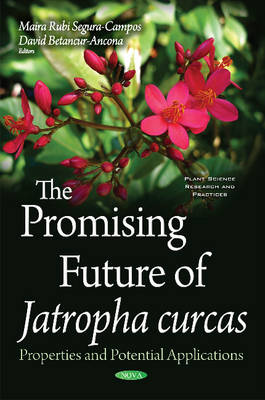23%OFF

Stock image for illustration purposes only - book cover, edition or condition may vary.
Promising Future of Jatropha Curcas: Properties & Potential Applications
Maira Segura-Campos
€ 234.77
€ 179.66
FREE Delivery in Ireland
Description for Promising Future of Jatropha Curcas: Properties & Potential Applications
Hardback. Editor(s): Betancur-Ancona, David. Num Pages: 263 pages, illustrations. BIC Classification: PST. Category: (G) General (US: Trade). Dimension: 185 x 260 x 19. Weight in Grams: 632.
J. curcas L. is a small or large shrub tree, up to 57m tall, belonging to the Euphorbiaceae family which consists of around 800 species and belongs to around321 genera. Jatropha is a drought resistant crop that has a life expectancy of up to fifty years. It is also known as Ratanjayot and the physic nut. It can grow in arid, semiarid and wasteland climates. The plant has its native distributional range in Mexico, Central America, Africa, Brazil, the Indian subcontinent, Peru, Argentina and Paraguay. J. curcas offers many benefits. Some of these benefits include: It costs almost nothing to grow; it is perennial, drought resistant and adapted for marginal land, and seems to be adequate for land reclamation; it can be grown almost anywhere even in sandy, saline, or otherwise infertile soil; it is easy to propagate; it is capable of stabilising sand dunes, acting as a windbreaker and combating desertification; it naturally repels both animals and insects; it does not exhaust the nutrients in the land; it does not require expensive crop rotation; it does not require fertilisers; and it grows quickly and establishes itself easily, among many other beneficial qualities. Currently, J. curcas can produce 2,000 L/ha oil annually. Presently, the production and usage of J. curcas oil is no longer confined to a specific geographic region or a limited number of end-products. Large quantities of J. curcas oil are consumed all over the world as ingredients of numerous products manufactured by a large number of industries. J. curcas was found to be suitable as a non-edible vegetable oil feedstock in oleochemical industries (biodiesel, fatty acids, soap, cosmetics, paraffin, fatty nitrogenous derivatives, surfactants and detergents, etc.). To supply J. curcas oil and its derived ingredients to these industries and their customers, an integrated J. curcas oil production has been developed over the years. Globally, J. curcas has created an interest for researchers because it is a non-edible oil, does not create a food versus fuel conflict, and can be used to produce biodiesel with same or better performance results when tested in diesel engines. For the above mentioned, the purpose of this book is to provide an insight into the possibilities of applying J. curcas for commercial purposes. Emphasis will be placed on the biology, chemistry and potential uses of J. curcas and its derivatives.
Product Details
Publisher
Nova Science Publishers Inc
Format
Hardback
Publication date
2016
Condition
New
Number of Pages
263
Place of Publication
New York, United States
ISBN
9781634849890
SKU
V9781634849890
Shipping Time
Usually ships in 5 to 9 working days
Ref
99-2
About Maira Segura-Campos
Maira Rubi Segura Campos. Dietitian Biologist Chemist (2004), Faculty of Chemistry, Universidad Autonoma de Yucatan (UADY); MSc in Food Science and Technology (2007), Faculty of Chemical Engineering (UADY); Ph.D. in Agricultural Science, Campus of Biological and Agricultural Science (2010) (UADY). Is professor research and Food Science Laboratory Head from Faculty of Chemical Engineering (UADY) in Mexico. She is National Researcher Level I (2012-2018) of the National System of Researchers and has collaborations with national and international research groups. She is responsible and contributor of different research projects and author of national and international articles, books, congress memories book chapters as well as advisor of undergraduate and graduate thesis. David Betancur-Ancona is Professor and Researcher of Food Science and technology in Faculty of Chemical Engineering at the Autonomous University of Yucatan in Mexico. He is received in Graduate in Biochemical Engineering, MSc in Food Science and Technology and PhD in Food Sciences. He is National Researcher Level III (2014-2017) of the National System of Researchers. He is responsible and contributor of research projects and author of indexed articles, books, and book chapters. Advisor of undergraduate and graduate thesis. Since 2000, he has collaborated with national and international networks to develop multidisciplinary research projects.
Reviews for Promising Future of Jatropha Curcas: Properties & Potential Applications
